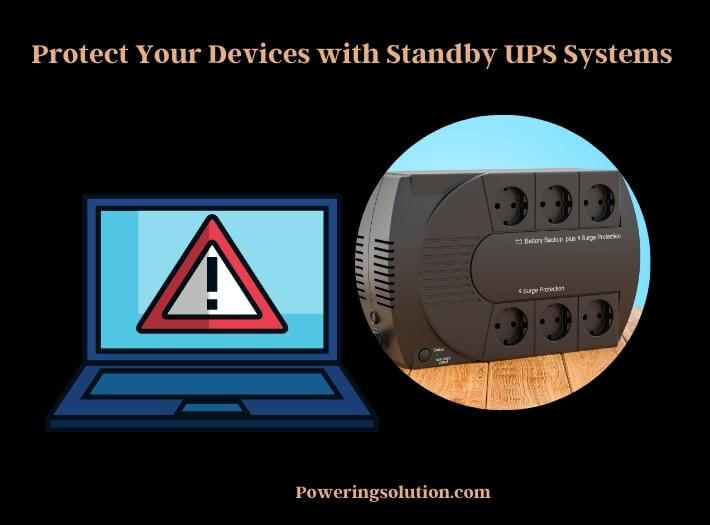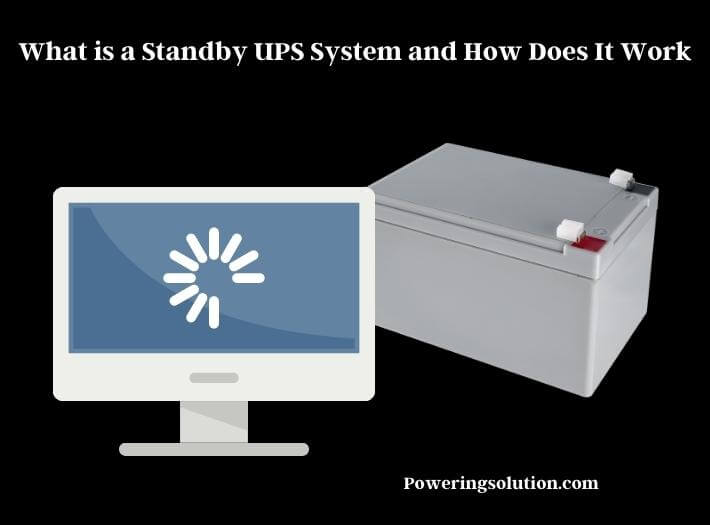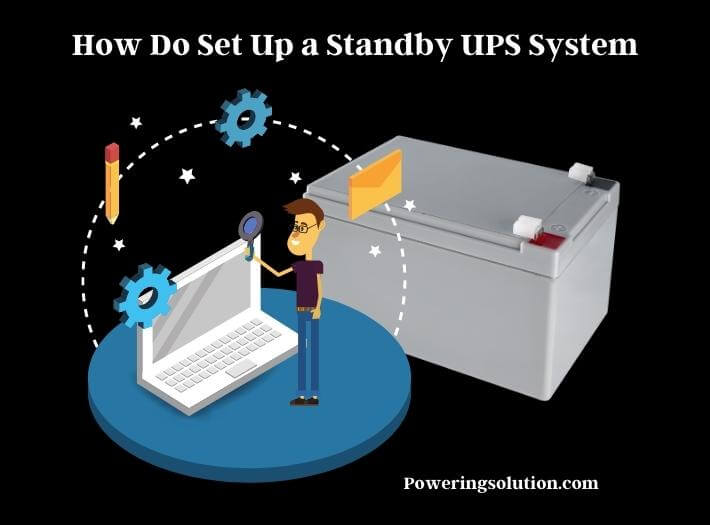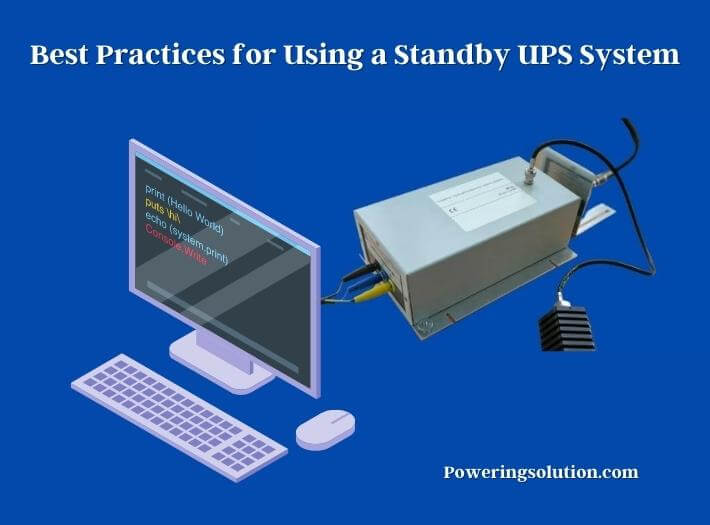In today’s fast-paced world, our reliance on electronic devices is increasing exponentially. From smartphones to laptops and other electronic equipment, we depend on them for our personal and professional lives. The importance of protecting these devices from power surges, spikes, and outages is often overlooked.

Power outages can be caused by various reasons, including natural disasters, accidents, or power grid failures. These outages can cause significant damage to electronic equipment and result in data loss, expensive repairs, or even complete equipment failure. Therefore, it is essential to have a reliable power backup system that can safeguard your electronic equipment from such risks.
Standby Uninterruptible Power Supply (UPS) systems have become increasingly popular in recent years as a solution to this problem. These systems provide an extra layer of protection against power outages and voltage fluctuations.
What is a Standby UPS System and How Does It Work?
A Standby Uninterruptible Power Supply (UPS) system is an electrical device that provides backup power to electronic equipment during power outages or voltage fluctuations. It operates by converting DC power from a battery to AC power, which is used to power the connected electronic devices.
In normal operation, the connected electronic devices are powered by the utility power, which is AC power provided by the electrical grid. The Standby UPS system continuously monitors the utility power and when it detects a voltage drop or outage, it immediately switches to battery power to keep the connected devices running without any interruption.

The switching time from utility power to battery power is typically less than 10 milliseconds, which is fast enough to prevent any interruption in the power supply to the connected devices. When the utility power is restored, the Standby UPS system switches back to the utility power and starts recharging the battery for the next power outage.
Standby UPS systems are commonly used for protecting personal computers, network equipment, and other critical electronic devices. They are also used in data centers and other mission-critical applications where even a momentary power outage can cause significant damage or data loss.
The Standby UPS system also provides protection against power surges and spikes, which can cause damage to electronic devices. It acts as a surge protector by filtering out any voltage fluctuations or power spikes that could damage the connected devices.
If you’re looking for a reliable source of power that can keep your devices running, whether, during a power outage or outdoor activities, inverter generators are an excellent option. Compared to conventional generators, inverter generators offer numerous advantages such as efficiency, portability, quiet operation, and clean power output.
Advantages of Using a Standby UPS System
Using a Standby Uninterruptible Power Supply (UPS) system provides several advantages, including:
Power Protection
The primary advantage of using a Standby UPS system is that it protects your electronic devices from power-related problems such as power outages, voltage fluctuations, and power surges. It ensures that your equipment remains functional and secure during power outages, which can prevent data loss, equipment damage, and other costly problems.
Uninterrupted Power Supply
Standby UPS systems provide an uninterrupted power supply to connected devices during power outages. This uninterrupted power supply ensures that critical applications, such as data centers and other mission-critical applications, remain operational without any interruption.
Extended Equipment Life
The Standby UPS system can extend the life of your electronic devices by protecting them from power-related problems. Power outages and voltage fluctuations can cause damage to electronic devices, and over time, this damage can reduce the lifespan of your equipment. By providing protection against these issues, a Standby UPS system can extend the life of your equipment and reduce the need for costly repairs or replacements.
Reduced Downtime
Downtime can be a significant problem for businesses and organizations that rely on electronic devices. The Standby UPS system can help reduce downtime by ensuring that critical applications remain operational during power outages. This reduces the risk of lost productivity and revenue due to system downtime.
Energy Efficiency
Standby UPS systems are energy-efficient and can help reduce energy consumption. These systems are designed to conserve energy by using the battery only when necessary, which reduces energy waste and lowers your energy bills.
Types of Standby UPS Systems
There are several types of Standby Uninterruptible Power Supply (UPS) systems available in the market. Here are some of the most common types:
| Offline/Standby UPS | This is the most basic type of Standby UPS system. In this system, the electronic devices are connected to the main power supply, and the UPS system remains on standby mode until a power outage occurs. When a power outage occurs, the system switches to battery power and provides an uninterrupted power supply to the connected devices. |
| Line-Interactive UPS | The Line-Interactive UPS system is more advanced than the offline/standby UPS. It provides automatic voltage regulation to the connected devices, which ensures that the devices receive a stable and consistent power supply. In this system, the battery backup is used only when the voltage fluctuations exceed a certain limit. |
| Online/Double Conversion UPS | This type of UPS system provides the highest level of power protection. In this system, the devices are always connected to the battery backup, and the battery backup is constantly charging. When a power outage occurs, the devices switch to the battery power without any delay. This system provides a consistent and clean power supply, which ensures the safety and reliability of the connected devices. |
| Standby-Ferro UPS | This is a less common type of UPS system, which uses a ferroresonant transformer to regulate the voltage. This system is highly reliable and can provide a consistent power supply to the connected devices, even during power fluctuations. |
| Hybrid UPS | This type of UPS system combines the features of both offline/standby and line-interactive UPS systems. It provides automatic voltage regulation to the connected devices, and the battery backup is used only when the voltage fluctuations exceed a certain limit. |
Each type of Standby UPS system has its own advantages and disadvantages, and choosing the right type of system depends on the specific needs of the user. It is important to carefully evaluate the features and capabilities of each system before making a decision.
Factors to Consider When Choosing a Standby UPS System
Choosing the right Standby UPS system is crucial to ensure the safety and reliability of your electronic devices.
Power Requirements
The power requirements of your electronic devices should be the primary consideration when choosing a Standby UPS system. You need to make sure that the UPS system is capable of providing enough power to the connected devices. It is important to consider both the maximum power requirements and the typical power usage of the devices.
Battery Backup Time
The battery backup time is an important factor to consider, especially if your devices require an uninterrupted power supply for extended periods of time. You need to choose a UPS system with a battery backup time that is sufficient for your needs.
Voltage Regulation
Voltage fluctuations can cause serious damage to electronic devices. It is important to choose a UPS system that provides automatic voltage regulation to ensure a stable and consistent power supply to the connected devices.
Surge Protection
Power surges and spikes can cause significant damage to electronic devices. You should choose a UPS system that provides surge protection to protect your devices from voltage spikes and surges.
Noise Level
Some Standby UPS systems can generate a significant amount of noise, which can be a problem in certain environments. If you plan to use the UPS system in a quiet environment, you should choose a system with a low noise level.
Size and Form Factor
The size and form factor of the UPS system is important considerations, especially if you have limited space. You should choose a system that fits your available space and is easy to install and maintain.
Cost
Cost is always a factor to consider when making any purchase. You should choose a UPS system that offers the features and capabilities you need at a price that fits your budget.
How Do Set Up a Standby UPS System?
Setting up a Standby UPS system is a straightforward process that can be completed in just a few simple steps. Here is a step-by-step guide on how to set up a Standby UPS system:

- The first step is to unpack the UPS system and make sure all the components are present. You should have the UPS unit, power cable, and any other accessories that came with the system.
- Choose a location for the UPS system that is close to the devices that you want to protect. Make sure the location is dry, cool, and well-ventilated to prevent overheating.
- Connect the devices that you want to protect to the UPS system using the appropriate cables. Make sure to connect each device to the appropriate outlet on the UPS system.
- Connect the power cable to the UPS system and plug it into a wall outlet. Make sure the wall outlet is grounded and provides a stable power supply.
- Turn on the UPS system using the power switch located on the unit. You should hear a beep to indicate that the UPS system is on.
- Once the UPS system is on, test it to make sure it is working properly. You can test the system by unplugging the power cable from the wall outlet and checking if the connected devices remain on.
- If the UPS system came with any software, install it on your computer to monitor the status of the UPS system and receive alerts if there are any issues.
If you follow these simple steps, you can set up a Standby UPS system and protect your electronic devices from power outages, voltage fluctuations, and other power-related issues. It is important to test the UPS system regularly to ensure that it is working properly and providing the necessary protection for your devices.
Best Practices for Using a Standby UPS System
Using a Standby UPS system is a great way to protect your electronic devices from power-related issues. It is important to perform regular maintenance on the UPS system to ensure that it is working properly. This includes checking the battery status, cleaning the unit, and performing any necessary firmware updates.

Make sure not to overload the UPS system by connecting too many devices. Overloading can cause the UPS system to shut down, which can lead to data loss and other issues.
It is important to check the power quality of your electrical outlets regularly. Power quality issues, such as voltage fluctuations and power surges, can damage your electronic devices and the UPS system itself.
Test the UPS system regularly to ensure that it is working properly. This includes testing the battery backup, monitoring the output voltage, and checking the system logs for any errors.
While a Standby UPS system is a great way to protect your electronic devices, it is important to have a backup plan in case of a power outage. This can include having backup batteries for your devices or a backup generator for your home or office.
Alternatives to Standby UPS Systems
While Standby UPS systems are a popular choice for protecting electronic devices from power-related issues, there are other alternatives available that may better suit your needs. Here are some of the most common alternatives:
Line Interactive UPS Systems
Line Interactive UPS systems are similar to Standby UPS systems, but they include additional features such as automatic voltage regulation (AVR) to provide a more stable output voltage. This type of UPS system is ideal for areas with unstable power supplies.
Double Conversion Online UPS Systems
Double Conversion Online UPS systems provide the highest level of protection for electronic devices. They convert incoming AC power to DC power, which is then converted back to AC power with a pure sine wave output. This type of UPS system is ideal for sensitive electronic equipment and data centers.
Surge Protectors
Surge protectors are devices that protect electronic devices from power surges and spikes. They are a cost-effective alternative to UPS systems, but they do not provide backup power in the event of a power outage.
Power Conditioners
Power conditioners are devices that improve the quality of the power supply to electronic devices by reducing noise and smoothing out voltage fluctuations. They are a good alternative to UPS systems for areas with stable power supplies.
Last Point
A Standby UPS system is an essential component for protecting electronic devices from power-related issues such as power outages, brownouts, and power surges. It provides backup power to ensure that your devices stay operational during a power outage and protects them from voltage fluctuations and spikes.
When choosing a Standby UPS system, it is important to consider factors such as the power rating, battery capacity, and the number of outlets required. It is also important to follow best practices such as regular maintenance, testing, and replacement of batteries to ensure optimal performance.
While Standby UPS systems are a popular choice, there are other alternatives available such as line interactive UPS systems, double conversion online UPS systems, surge protectors, and power conditioners. Choosing the right alternative depends on your specific needs and the level of protection required for your electronic devices.
In today’s world, electronic devices are an essential part of our daily lives, and protecting them from power-related issues is crucial. Investing in a Standby UPS system or an alternative will ensure the safety and longevity of your electronic devices.
